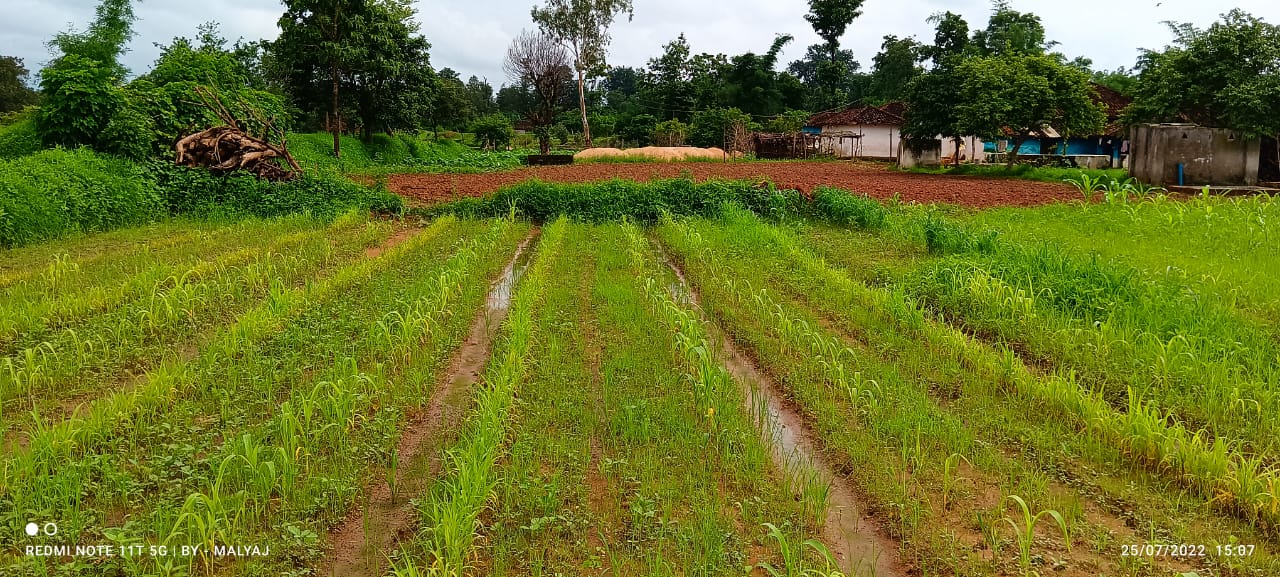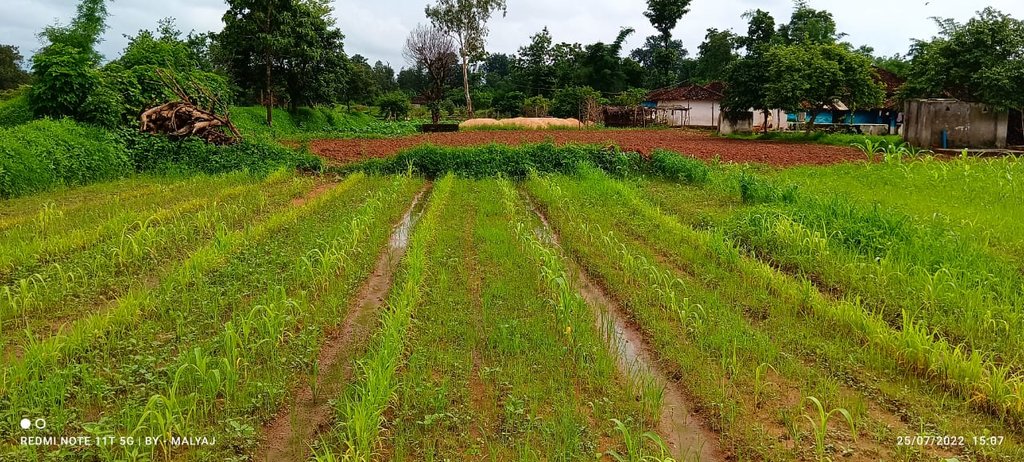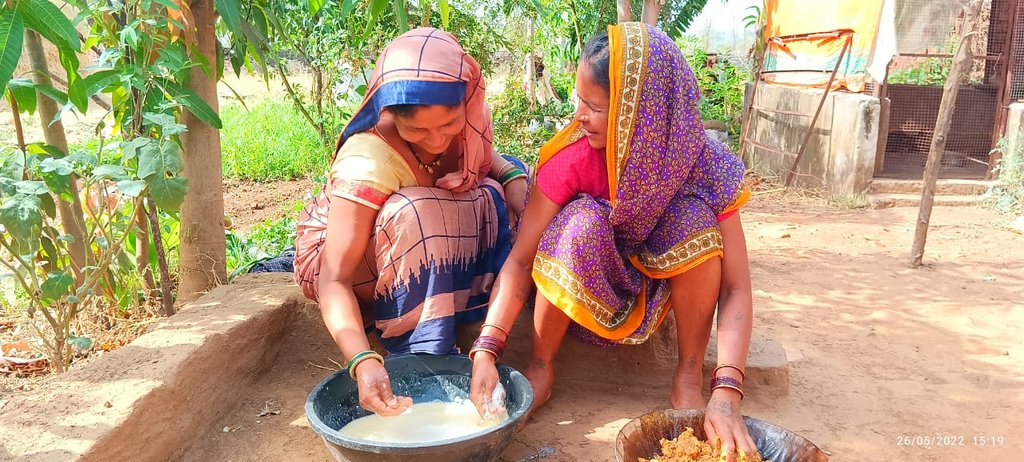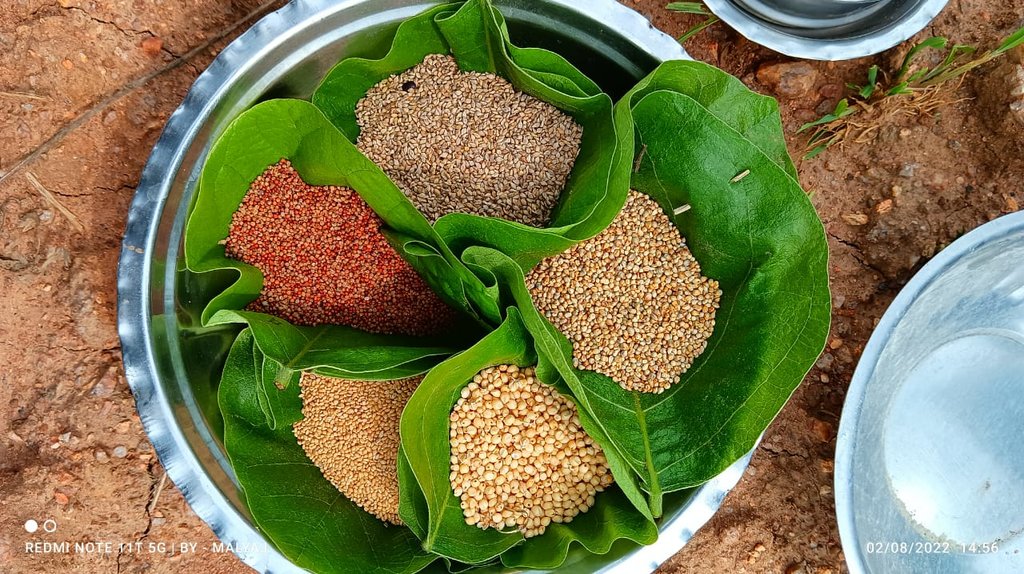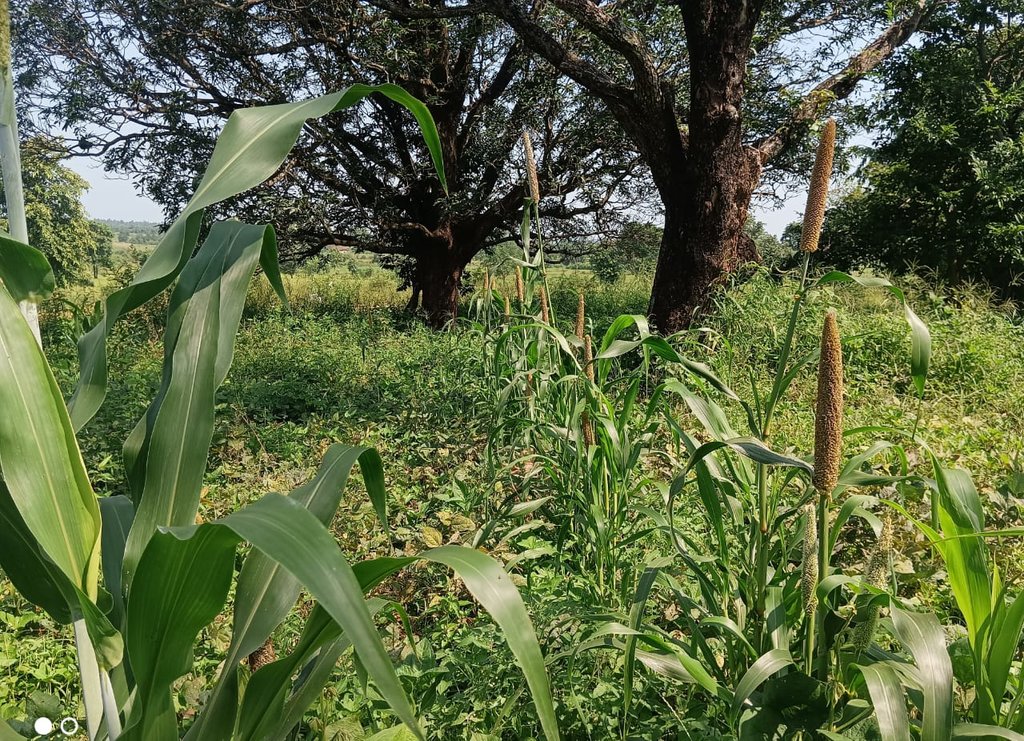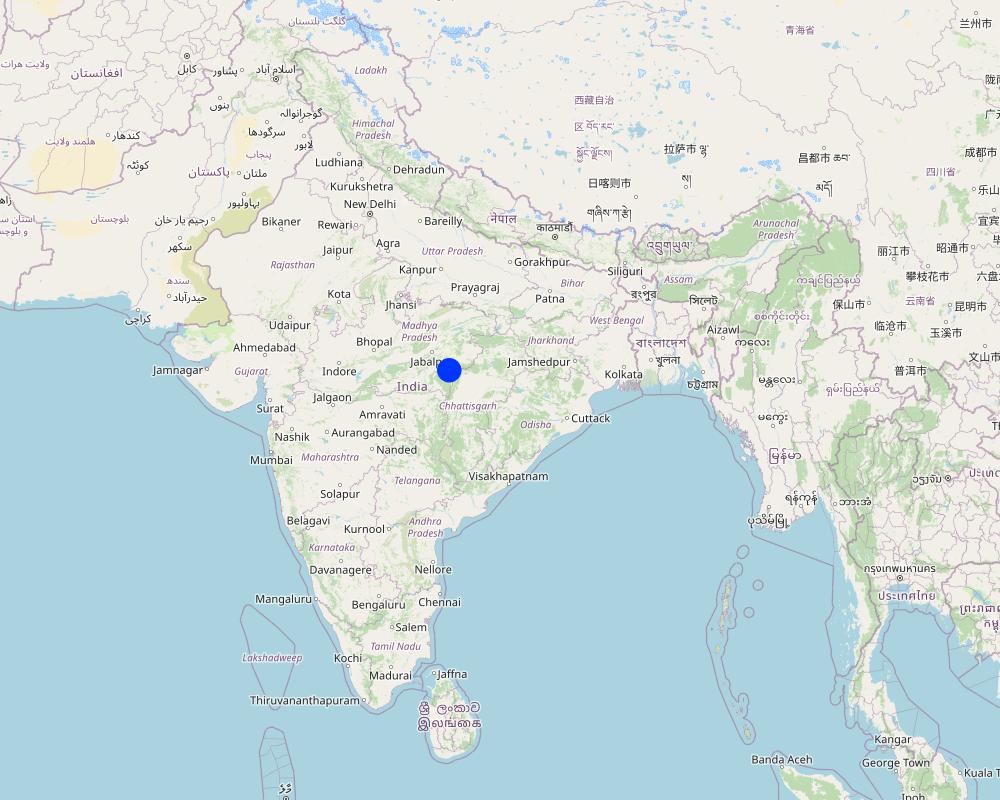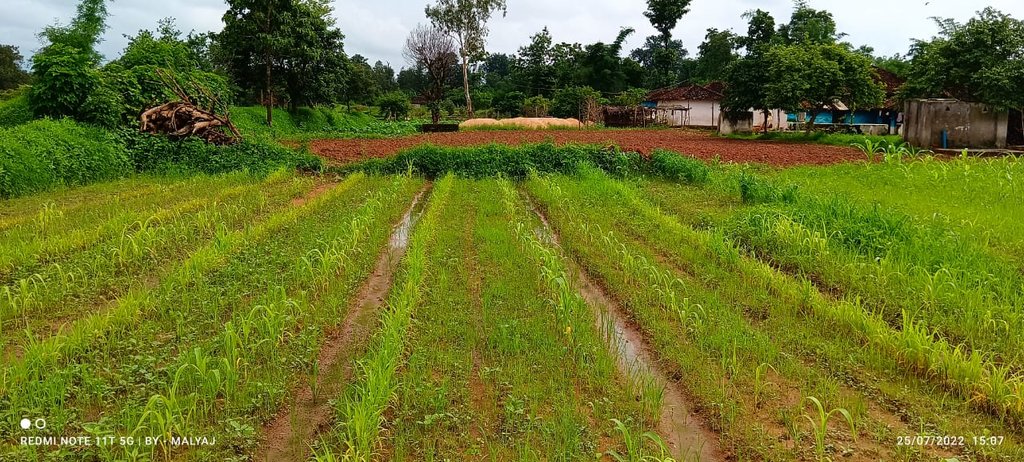Pre-Monsoon Dry Sowing (PMDS) [อินเดีย]
- ผู้สร้างสรรค์:
- การอัพเดท:
- ผู้รวบรวม: Santosh Gupta
- ผู้เรียบเรียง: Noel Templer, Stephanie Katsir, Kim Arora, Tabitha Nekesa, Ahmadou Gaye, Siagbé Golli
- ผู้ตรวจสอบ: Udo Höggel, Sally Bunning
technologies_6697 - อินเดีย
ดูส่วนย่อย
ขยายทั้งหมด ย่อทั้งหมด1. ข้อมูลทั่วไป
1.2 รายละเอียดที่ติดต่อได้ของผู้รวบรวมและองค์กรที่เกี่ยวข้องในการประเมินและการจัดเตรียมทำเอกสารของเทคโนโลยี
ชื่อของโครงการซึ่งอำนวยความสะดวกในการทำเอกสารหรือการประเมินเทคโนโลยี (ถ้าเกี่ยวข้อง)
Soil protection and rehabilitation for food security (ProSo(i)l)ชื่อขององค์กรซึ่งอำนวยความสะดวกในการทำเอกสารหรือการประเมินเทคโนโลยี (ถ้าเกี่ยวข้อง)
GIZ India (GIZ India) - อินเดียชื่อขององค์กรซึ่งอำนวยความสะดวกในการทำเอกสารหรือการประเมินเทคโนโลยี (ถ้าเกี่ยวข้อง)
Alliance Bioversity and International Center for Tropical Agriculture (Alliance Bioversity-CIAT) - เคนยาชื่อขององค์กรซึ่งอำนวยความสะดวกในการทำเอกสารหรือการประเมินเทคโนโลยี (ถ้าเกี่ยวข้อง)
Ecociate Consultants (Ecociate Consultants) - อินเดีย1.3 เงื่อนไขการใช้ข้อมูลที่ได้บันทึกผ่านทาง WOCAT
ผู้รวบรวมและวิทยากรหลักยอมรับเงื่อนไขเกี่ยวกับการใช้ข้อมูลที่ถูกบันทึกผ่านทาง WOCAT:
ใช่
1.4 การเปิดเผยเรื่องความยั่งยืนของเทคโนโลยีที่ได้อธิบายไว้
เทคโนโลยีที่ได้อธิบายไว้นี้เป็นปัญหาของความเสื่อมโทรมโทรมของที่ดินหรือไม่ จึงไม่ได้รับการยอมรับว่าเป็นเทคโนโลยีเพื่อการจัดการที่ดินอย่างยั่งยืน:
ไม่ใช่
แสดงความคิดเห็น:
The technology described here is related to sustainable land and other resource management systems.
2. การอธิบายลักษณะของเทคโนโลยี SLM
2.1 การอธิบายแบบสั้น ๆ ของเทคโนโลยี
คำจำกัดความของเทคโนโลยี:
The Pre-Monsoon Dry Sowing Technology aims to sow 12 to 15 different crop varieties in April without waiting for rain. To achieve this the seeds are pelletized with a mixture of clay soils, bio-inoculants like dried Ghanjeevamruth and Dravajeevamrit, and ash. The main objective of this technology is to empower rainfed farmers by utilizing the initial rainfall in April and May for crop cultivation. By using pelettized seeds, they can maximize the effectiveness of rainfall showers before the arrival of the monsoon season. Such seeds can also survive, if there are delay in the rainfall as the pellets around the seed help it in maintaining the moisture.
2.2 การอธิบายแบบละเอียดของเทคโนโลยี
คำอธิบาย:
Pre-monsoon dry sowing (PMDS) is a system of sowing, tilling and tending the land wherein the farmer grows crops in non-farming seasons or whenever there is no crop cover on the land. This can be practised before the advent of monsoon, during summer (April-May), after Kharif and before the beginning of the Rabi season (September and October). PMDS harnesses the water vapor from air that gets settled in the form of early morning dew. The dew supplies the required moisture to the soil. (Reference:-https://apcnf.in/wp-content/uploads/2022/05/IDS-2020-2021-APCNF-PMDS-Report.pdf)
In the study where PMDS was practised before the onset of the monsoon season, typically during the dry month of April. The seeds are pelletized with a mixture of clay soils, bio-inoculants, and ash, which creates a protective coating around the seed and helps it to germinate even in the case of delayed rains or very little rainfall. The coating around the seed, helps it to maintain moisture and support its germination. As the name suggests, the technology is good for utilising the pre-monsoon season by advancing the sowing cycles, using the usually dry months of summer and utilising the pre-monsoon rains.
This technology benefits rainfed areas where farmers rely solely on rainfall for irrigation. PMDS aims to promote an extended duration of crop cover under rainfed conditions, allowing farmers to cultivate crops with a reduced risk of crop failure in the cases of delayed or lower rainfall. Since seeds are germinated before the arrival of monsoon, there are times when they can also survive the heavy rains. This technology is useful in utilising moisture to the best extent possible as seeds are covered with the outer layer of clay and other stuff. In the Mandla District of Madhya Pradesh, farmers utilized seeds from their homes, comprising 12 to 15 crops, including cereals, pulses, and spices. These collected seeds were pelletized, dried for 24 hours, and broadcasted into minimally tilled soil. The diversified crop combination was grown until July and mixed with the soil before paddy transplanting. This process improves the soil's microbial activity, resulting in increased yields in crops grown before paddy and in the paddy crop itself. Therefore, the farmers benefit from increased production and yields through this technique of PMDS.
PMDS not only improves the economics of farmers but it also improves soil health. The covering of the soil with different crops protects it from heat, pounding rain, and wind. It also improves diversity in soil microorganisms, beneficial insects and other species. Covering soil for 365 days with plant diversity is also critical to protect soil health and balance climate change. PMDS can facilitate all these functions.
2.3 รูปภาพของเทคโนโลยี
2.5 ประเทศภูมิภาค หรือสถานที่ตั้งที่เทคโนโลยีได้นำไปใช้และได้รับการครอบคลุมโดยการประเมินนี้
ประเทศ:
อินเดีย
ภูมิภาค/รัฐ/จังหวัด:
Madhya Pradesh
ข้อมูลจำเพาะเพิ่มเติมของสถานที่ตั้ง :
Bichhiya block
ระบุการกระจายตัวของเทคโนโลยี:
- ใช้ ณ จุดที่เฉพาะเจาะจงหรือเน้นไปยังบริเวณพื้นที่ขนาดเล็ก
Is/are the technology site(s) located in a permanently protected area?
ไม่ใช่
แสดงความคิดเห็น:
The technology is applied by rainfed farmers in the Mandla District of Madhya Pradesh.
Map
×2.6 วันที่การดำเนินการ
ระบุปีที่ใช้:
2022
2.7 คำแนะนำของเทคโนโลยี
ให้ระบุว่าเทคโนโลยีถูกแนะนำเข้ามาอย่างไร:
- ในช่วงการทดลองหรือการทำวิจัย
- ทางโครงการหรือจากภายนอก
ความคิดเห็น (ประเภทของโครงการ เป็นต้น) :
The modified PMDS technology used in another program, the Andhra Pradesh Natural Farming Program, has been adopted here.
3. การจัดประเภทของเทคโนโลยี SLM
3.1 วัตถุประสงค์หลักของเทคโนโลยี
- ปรับปรุงการผลิตให้ดีขึ้น
- ลด ป้องกัน ฟื้นฟู การเสื่อมโทรมของที่ดิน
- รักษาสภาพหรือปรับปรุงความหลากหลายทางชีวภาพ
- ปรับตัวเข้ากับการเปลี่ยนแปลงภูมิอากาศของโลก สภาพภูมิอากาศที่รุนแรงและผลกระทบ
- สร้างผลกระทบทางด้านเศรษฐกิจที่เป็นประโยชน์
3.2 ประเภทของการใช้ที่ดินในปัจจุบันที่ได้นำเทคโนโลยีไปใช้
Land use mixed within the same land unit:
ไม่ใช่

พื้นที่ปลูกพืช
- การปลูกพืชล้มลุกอายุปีเดียว
Annual cropping - Specify crops:
- cereals - rice (wetland)
จำนวนของฤดูเพาะปลูกต่อปี:
- 1
ระบุ:
Generally, Paddy is transplanted in July Month in the Mandla District and harvested around November. This region is majorly rainfed, and only 9% of the area has some irrigation source.
Is intercropping practiced?
ไม่ใช่
Is crop rotation practiced?
ไม่ใช่
3.3 Has land use changed due to the implementation of the Technology?
Has land use changed due to the implementation of the Technology?
- Yes (Please fill out the questions below with regard to the land use before implementation of the Technology)
Land use mixed within the same land unit:
ไม่ใช่

พื้นที่ปลูกพืช
- การปลูกพืชล้มลุกอายุปีเดียว
Annual cropping - Specify crops:
- cereals - maize
- cereals - sorghum
- legumes and pulses - lentils
- Lentils include - Black gram, Cowpea, Green Gram, Red Gram and Oil seeds including sesame and Coriander.
Is intercropping practiced?
ใช่
If yes, specify which crops are intercropped:
The above mention crops are generally mixed together and grown on the same patches of land in April.
Is crop rotation practiced?
ไม่ใช่
แสดงความคิดเห็น:
The PMDS technology has enabled crop diversification in the Mandla District from April to July.
3.4 การใช้น้ำ
การใช้น้ำของที่ดินที่มีการใช้เทคโนโลยีอยู่:
- จากน้ำฝน
3.5 กลุ่ม SLM ที่ตรงกับเทคโนโลยีนี้
- การปรับปรุงดิน / พืชคลุมดิน
- การรบกวนดินให้น้อยที่สุด
- การจัดการความอุดมสมบรูณ์ของดินแบบผสมผสาน
3.6 มาตรการ SLM ที่ประกอบกันเป็นเทคโนโลยี

มาตรการจัดการพืช
- A1: พืช/สิ่งปกคลุมดิน
- A2: อินทรียวัตถุในดิน/ความอุดมสมบูรณ์ในดิน
- A6: Residue management
A6: Specify residue management:
A 6.4: retained

มาตรการอนุรักษ์ด้วยการจัดการ
- M1: การเปลี่ยนรูปแบบของการใช้ประโยชน์ที่ดิน
- M2: การเปลี่ยนแปลงของการจัดการหรือระดับความเข้มข้น
แสดงความคิดเห็น:
The PMDS (pre-monsoon dry sowing) technique involves crop diversification and the utilization of rainfed land from April to July, typically left unused, to improve soil health. This is achieved by planting green crops that are later harvested, leaving the crop biomass in the soil to retain moisture, and subsequently growing paddy crops on the same land. This approach has the added benefit of increasing yields, improving crop quality, and reducing farmers' reliance on only one single crop.
3.7 รูปแบบหลักของการเสื่อมโทรมของที่ดินที่ได้รับการแก้ไขโดยเทคโนโลยี

การกัดกร่อนของดินโดยน้ำ
- Wt (Loss of topsoil): การสูญเสียดินชั้นบนหรือการกัดกร่อนที่ผิวดิน

การเสื่อมโทรมของดินทางด้านกายภาพ
- Pc (Compaction): การอัดแน่น
- Pu (Loss of bio-productive function): การสูญเสียหน้าที่การผลิตทางชีวภาพอันเนื่องมาจากกิจกรรม อื่นๆ

การเสื่อมโทรมของดินทางด้านชีวภาพ
- Bc (Reduction of vegetation cover): การลดลงของจำนวนพืชที่ปกคลุมดิน
แสดงความคิดเห็น:
Mandla district receives rainfall of around 1500mm, and soil is highly susceptible to erosion. Covering the soil with different crops reduces the erosion potential, and mixing the soil with biomass improves soil health.
3.8 การป้องกัน การลดลง หรือการฟื้นฟูความเสื่อมโทรมของที่ดิน
ระบุเป้าหมายของเทคโนโลยีกับความเสื่อมโทรมของที่ดิน:
- ป้องกันความเสื่อมโทรมของที่ดิน
- ลดความเสื่อมโทรมของดิน
แสดงความคิดเห็น:
Land degradation by water erosion is reduced by covering the topsoil with crops for an extended duration. The addition of crop biomass improves soil health.
4. ข้อมูลจำเพาะด้านเทคนิค กิจกรรมการนำไปปฏิบัติใช้ ปัจจัยนำเข้า และค่าใช้จ่าย
4.1 แบบแปลนทางเทคนิคของเทคโนโลยี
ข้อมูลจำเพาะด้านเทคนิค (แบบแปลนทางเทคนิคของเทคโนโลยี):
PMDS was undertaken at various sizes of plots based on the availability of land with farmers. Some farmers did at 0.10 acres of land while others did at 2 acres. Also, there was no fixed pattern that was followed for the quantity and variety of seeds. Whatever seeds were available were sown. In the image above, it can be seen that the field where PMDS was undertaken has multiple crops at different stages of their growth while the area with no PMDS has no crop and fallow red soil can be seen.
ผู้เขียน:
Santosh
วันที่:
22/02/2023
4.2 ข้อมูลทั่วไปเกี่ยวกับการคำนวณปัจจัยนำเข้าและค่าใช้จ่าย
ให้ระบุว่าค่าใช้จ่ายและปัจจัยนำเข้าได้รับการคำนวณอย่างไร:
- ต่อพื้นที่ที่ใช้เทคโนโลยี
ระบุขนาดและหน่วยพื้นที่:
1 acre
อื่นๆ หรือสกุลเงินประจำชาติ (ระบุ):
INR (March, 2023)
If relevant, indicate exchange rate from USD to local currency (e.g. 1 USD = 79.9 Brazilian Real): 1 USD =:
82.5
ระบุค่าเฉลี่ยของค่าจ้างในการจ้างแรงงานต่อวัน:
204 INR
4.3 กิจกรรมเพื่อการจัดตั้ง
แสดงความคิดเห็น:
There are no establishment activities under the PMDS.
4.4 ค่าใช้จ่ายของปัจจัยนำเข้าที่จำเป็นสำหรับการจัดตั้ง
แสดงความคิดเห็น:
There are no establishment costs required for PMDS as it's only a sowing activity. Farmers do hire agriculture equipments to undertake the activity.
4.5 การบำรุงรักษาสภาพหรือกิจกรรมที่เกิดขึ้นเป็นประจำ
| กิจกรรม | ช่วงระยะเวลา/ความถี่ | |
|---|---|---|
| 1. | Collection of seeds | 1 month before the onset of Monsoon (mid May in project area) |
| 2. | Seed treatment and preparation of seed balls | End of May in project area |
| 3. | Broadcasting of the seed balls | End of May in project area |
| 4. | Soil rotation | 2-3 days after the broadcasting of seed balls |
| 5. | Harvesting of leafy vegetables, fodder and other produces | Mid of June to mid of July |
| 6. | Mixing the green manure in soils | End of July or before transplantation of rice |
4.6 ค่าใช้จ่ายของปัจจัยนำเข้าและกิจกรรมที่เกิดขึ้นเป็นประจำที่ต้องการการบำรุงรักษา (ต่อปี)
| ปัจจัยนำเข้า | หน่วย | ปริมาณ | ค่าใช้จ่ายต่อหน่วย | ค่าใช้จ่ายทั้งหมดต่อปัจจัยนำเข้า | %ของค่าใช้จ่ายที่ก่อให้เกิดขึ้นโดยผู้ใช้ที่ดิน | |
|---|---|---|---|---|---|---|
| แรงงาน | Seed treatment, preparation of seed balls | Person days | 1.0 | 200.0 | 200.0 | 100.0 |
| แรงงาน | Broadcasting of seeds | Person days | 1.0 | 200.0 | 200.0 | 100.0 |
| แรงงาน | Harvesting of the crops | Person days | 2.0 | 150.0 | 300.0 | 100.0 |
| อุปกรณ์ | Agriculture equipment for soil rotation | Hour | 0.5 | 600.0 | 300.0 | 100.0 |
| อุปกรณ์ | Cultivator | Hour | 1.0 | 600.0 | 600.0 | 100.0 |
| วัสดุด้านพืช | Seeds of different crops | kg | 6.0 | 75.0 | 450.0 | 100.0 |
| ปุ๋ยและสารฆ่า/ยับยั้งการเจริญเติบโตของสิ่งมีชีวิต (ไบโอไซด์) | Bio-inputs | LS | 1.0 | 400.0 | 400.0 | 100.0 |
| ค่าใช้จ่ายทั้งหมดของการบำรุงรักษาสภาพเทคโนโลยี | 2450.0 | |||||
| Total costs for maintenance of the Technology in USD | 29.7 | |||||
แสดงความคิดเห็น:
Technical inputs were provided from the project around the seed treatment, sowing, and monitoring of the crops.
4.7 ปัจจัยสำคัญที่สุดที่มีผลกระทบต่อค่าใช้จ่าย
ปัจจัยสำคัญที่สุดที่มีผลกระทบต่อค่าใช้จ่ายต่างๆ:
Availability of seeds, bio-inputs, and rainfall pattern. Usually, there are rains during the pre-monsoon season in the project area, however, in case of no rains at all during the entire summer, farmers may not be in a position to achieve the desired results.
5. สิ่งแวดล้อมทางธรรมชาติและของมนุษย์
5.1 ภูมิอากาศ
ฝนประจำปี
- < 250 ม.ม.
- 251-500 ม.ม.
- 501-750 ม.ม.
- 751-1,000 ม.ม.
- 1,001-1,500 ม.ม.
- 1,501-2,000 ม.ม.
- 2,001-3,000 ม.ม.
- 3,001-4,000 ม.ม.
- > 4,000 ม.ม.
ระบุปริมาณน้ำฝนเฉลี่ยรายปี (ถ้ารู้) :หน่วย ม.ม.
1427.00
ข้อมูลจำเพาะ/ความคิดเห็นเรื่องปริมาณน้ำฝน:
Monsoon season is from June-September, which has the majority of the rainfall.
ระบุชื่อของสถานีตรวดวัดอากาศที่ใช้อ้างอิงคือ:
District at glance report of Ministry of Water Resources, Central Groundwater Board, North Central Region BHOPAL, 2013
เขตภูมิอากาศเกษตร
- กึ่งชุ่มชื้น
- กึ่งแห้งแล้ง
The National Bureau of Soil Survey & Land Use Planning (NBSS&LUP) developed twenty agroecological zones based on the growing period as an integrated criterion of adequate rainfall, and soil groups. It delineated boundaries adjusted to district boundaries with a minimal number of regions. Mandla District of Madhya Pradesh lies in a Hot subhumid ecoregion with red and black soil. Precepitation - 1000–1500mm; Potential evapotranspiration -1300–1500 mm; Length of growing period-150–180days.
5.2 สภาพภูมิประเทศ
ค่าเฉลี่ยความลาดชัน:
- ราบเรียบ (0-2%)
- ลาดที่ไม่ชัน (3-5%)
- ปานกลาง (6-10%)
- เป็นลูกคลื่น (11-15%)
- เป็นเนิน (16-30%)
- ชัน (31-60%)
- ชันมาก (>60%)
ธรณีสัณฐาน:
- ที่ราบสูง/ที่ราบ
- สันเขา
- ไหล่เขา
- ไหล่เนินเขา
- ตีนเนิน
- หุบเขา
ระดับความสูง:
- 0-100 เมตร
- 101-500 เมตร
- 501-1,000 เมตร
- 1,001-1,500 เมตร
- 1,501-2,000 เมตร
- 2,001-2,500 เมตร
- 2,501-3,000 เมตร
- 3,001-4,000 เมตร
- > 4,000 เมตร
ให้ระบุถ้าเทคโนโลยีได้ถูกนำไปใช้:
- ไม่เกี่ยวข้อง
ความคิดเห็นและข้อมูลจำเพาะเพิ่มเติมเรื่องสภาพภูมิประเทศ:
Bichhiya is a block in the Mandla district characterized by diverse topography. The block is located in the southern part of the District and is situated in the foothills of the Satpura range.
The topography of the Bichhiya block is hilly. The block has an average elevation of around 550 meters above sea level. The hills are covered with forests and are rich in flora and fauna.
The region has several small streams and tributaries that flow through it, which are mostly seasonal and originate in the hills.
5.3 ดิน
ค่าเฉลี่ยความลึกของดิน:
- ตื้นมาก (0-20 ซ.ม.)
- ตื้น (21-50 ซ.ม.)
- ลึกปานกลาง (51-80 ซ.ม.)
- ลึก (81-120 ซ.ม.)
- ลึกมาก (>120 ซ.ม.)
เนื้อดิน (ดินชั้นบน):
- หยาบ/เบา (ดินทราย)
เนื้อดินล่าง (> 20 ซ.ม.ต่ำจากผิวดิน):
- ปานกลาง (ดินร่วน ทรายแป้ง)
อินทรียวัตถุในดิน:
- ต่ำ (<1%)
5.4 ความเป็นประโยชน์และคุณภาพของน้ำ
ระดับน้ำใต้ดิน:
5-50 เมตร
น้ำไหลบ่าที่ผิวดิน:
ปานกลาง
คุณภาพน้ำ (ที่ยังไม่ได้บำบัด):
เป็นน้ำเพื่อการดื่มที่ไม่ดี (จำเป็นต้องได้รับการบำบัด)
Water quality refers to:
both ground and surface water
ความเค็มของน้ำเป็นปัญหาหรือไม่:
ไม่ใช่
กำลังเกิดน้ำท่วมในพื้นที่หรือไม่:
ไม่ใช่
ความคิดเห็นและข้อมูลจำเพาะเพิ่มเติมเรื่องคุณภาพและปริมาณน้ำ:
The region has several small streams and tributaries that flow through it, primarily seasonal and originating in the hills. The area is also known for its waterfalls, including the Patalpani waterfall, a popular tourist destination.
5.5 ความหลากหลายทางชีวภาพ
ความหลากหลายทางชนิดพันธุ์:
- สูง
ความหลากหลายของแหล่งที่อยู่:
- สูง
ความคิดเห็นและข้อมูลจำเพาะเพิ่มเติมของความหลากหลายทางชีวภาพ:
The area is surrounded by Kasha National Park and Phen Wildlife Sanctuary, with a good presence of forest area. Thus biodiversity is outstanding.
5.6 ลักษณะของผู้ใช้ที่ดินที่นำเทคโนโลยีไปปฏิบัติใช้
อยู่กับที่หรือเร่ร่อน:
- อยู่กับที่
แนวทางการตลาดของระบบการผลิต:
- mixed (subsistence/ commercial)
รายได้ที่มาจากนอกฟาร์ม:
- > 50% ของรายได้ทั้งหมด
ระดับของความมั่งคั่งโดยเปรียบเทียบ:
- จน
เป็นรายบุคคล/ครัวเรือน:
- เป็นรายบุคคล/ครัวเรือน
ระดับของการใช้เครื่องจักรกล:
- งานที่ใช้แรงกาย
- การใช้กำลังจากสัตว์
เพศ:
- หญิง
- ชาย
อายุของผู้ใช้ที่ดิน:
- ผู้เยาว์
- วัยกลางคน
ระบุลักษณะอื่นๆที่เกี่ยวข้องของผู้ใช้ที่ดิน:
Bichhiya block has a significant tribal population. According to the 2011 Census of India, the block has a total population of around 47,000, of which approximately 41% are classified as Scheduled Tribes (STs). The powerful tribes inhabiting the region include the Gonds, Baigas, and Korkus.
5.7 Average area of land used by land users applying the Technology
- < 0.5 เฮกตาร์
- 0.5-1 เฮกตาร์
- 1-2 เฮกตาร์
- 2-5 เฮกตาร์
- 5-15 เฮกตาร์
- 15-50 เฮกตาร์
- 50-100 เฮกตาร์
- 100-500 เฮกตาร์
- 500-1,000 เฮกตาร์
- 1,000-10,000 เฮกตาร์
- >10,000 เฮกตาร์
พิจารณาว่าเป็นขนาดเล็ก กลาง หรือขนาดใหญ่ (ซึ่งอ้างอิงถึงบริบทระดับท้องถิ่น):
- ขนาดเล็ก
5.8 กรรมสิทธิ์ในที่ดิน สิทธิในการใช้ที่ดินและสิทธิในการใช้น้ำ
กรรมสิทธิ์ในที่ดิน:
- รายบุคคล ได้รับสิทธิครอบครอง
สิทธิในการใช้ที่ดิน:
- รายบุคคล
สิทธิในการใช้น้ำ:
- เกี่ยวกับชุมชน (ถูกจัดระเบียบ)
- รายบุคคล
Are land use rights based on a traditional legal system?
ใช่
5.9 การเข้าถึงบริการและโครงสร้างพื้นฐาน
สุขภาพ:
- จน
- ปานกลาง
- ดี
การศึกษา:
- จน
- ปานกลาง
- ดี
ความช่วยเหลือทางด้านเทคนิค:
- จน
- ปานกลาง
- ดี
การจ้างงาน (เช่น ภายนอกฟาร์ม):
- จน
- ปานกลาง
- ดี
ตลาด:
- จน
- ปานกลาง
- ดี
พลังงาน:
- จน
- ปานกลาง
- ดี
ถนนและการขนส่ง:
- จน
- ปานกลาง
- ดี
น้ำดื่มและการสุขาภิบาล:
- จน
- ปานกลาง
- ดี
บริการด้านการเงิน:
- จน
- ปานกลาง
- ดี
6. ผลกระทบและสรุปคำบอกกล่าว
6.1 ผลกระทบในพื้นที่ดำเนินการ (On-site) จากการใช้เทคโนโลยี
ผลกระทบทางด้านเศรษฐกิจและสังคม
การผลิต
การผลิตพืชผล
แสดงความคิดเห็น/ระบุ:
Based on the discussion with land users and implanting agency, production of the main crop (Paddy) increased by 20-25%. (The crop combination under PMDS has some nitrogen-fixing crops and the crop biomass improves the nutrient availability for the next crop which is paddy, also the better moisture helped the improvement in productivity of paddy crop as well.). Additional production from crops sown in April month was generated. An impact assessment study to document the quantifiable results has not been conducted so far.
การเสี่ยงต่อความล้มเหลวในการผลิต
แสดงความคิดเห็น/ระบุ:
Risk of of production failure reduced due to crop diversification
ความหลากหลายของผลิตภัณฑ์
แสดงความคิดเห็น/ระบุ:
Crop diversification by sowing multi crops of cereals, millets, pulses, and oilseeds in otherwise paddy predominant area
พื้นที่สำหรับการผลิต
แสดงความคิดเห็น/ระบุ:
The gross sown area increased as the land was brought under cultivation from April to July
การจัดการที่ดิน
แสดงความคิดเห็น/ระบุ:
Through this technology crop biomass was added to improve soil to improve its organic content and structure
รายได้และค่าใช้จ่าย
รายได้จากฟาร์ม
แสดงความคิดเห็น/ระบุ:
Increase in farm income due to additional crop production and increase in yield of the main crop
ความหลากหลายของแหล่งผลิตรายได้
แสดงความคิดเห็น/ระบุ:
12 to 15 different crops are grown in PMDS, reducing the crop failure chances and improvements in soil structure, therefore storing the soil moisture for an extended duration
ผลกระทบด้านสังคมวัฒนธรรมอื่น ๆ
ความมั่นคงด้านอาหาร / พึ่งตนเองได้
แสดงความคิดเห็น/ระบุ:
Diversity in crops will reflect in increased and more diverse food availability
ผลกระทบด้านนิเวศวิทยา
วัฐจักรน้ำหรือน้ำบ่า
การระเหย
แสดงความคิดเห็น/ระบุ:
Reduction in evaporation loss from April to July and effective utilization of soil moisture and rainfall in this duration
ดิน
ความชื้นในดิน
แสดงความคิดเห็น/ระบุ:
Improved soil structure due to the addition of crop biomass in the soil leads to the retention of soil moisture. The extended duration of crop cover also reduces evaporation losses.
สิ่งปกคลุมดิน
แสดงความคิดเห็น/ระบุ:
Extended duration of crop cover from April - July
การสูญเสียดิน
แสดงความคิดเห็น/ระบุ:
Reduction in soil loss due to crop cover
การหมุนเวียนและการเติมของธาตุอาหาร
แสดงความคิดเห็น/ระบุ:
Crop biomass increases organic carbon in the soil improving the availability of nutrient in the soil
ความหลากหลายทางชีวภาพของพืชและสัตว์
การปกคลุมด้วยพืช
แสดงความคิดเห็น/ระบุ:
Extended duration of vegetation cover of the soil
มวลชีวภาพ/เหนือดินชั้น C
แสดงความคิดเห็น/ระบุ:
Increase in biomass above ground by using pre-monsoon rainfall
ความหลากหลายทางชีวภาพของพืช
แสดงความคิดเห็น/ระบุ:
12-15 different crops are sown togehter
ลดความเสี่ยงของภัยพิบัติ
ภูมิอากาศจุลภาค
Specify assessment of on-site impacts (measurements):
All the impacts indicated here are based on the discussions with land users and implementing agency. The reported outcomes are based on eye observations and estimations. Some of the impacts are also based on the reports and secondary documents published on the PMDS.
6.2 ผลกระทบนอกพื้นที่ดำเนินการ (Off-site) จากการใช้เทคโนโลยี
Specify assessment of off-site impacts (measurements):
PMDS method is farmland-specific technology wherein effective utilization of natural resources (land and rainfall) is done. Therefore no direct off site impact of the technology is observed.
6.3 การเผชิญและความตอบสนองของเทคโนโลยีต่อการเปลี่ยนแปลงสภาพภูมิอากาศที่ค่อยเป็นค่อยไป และสภาพรุนแรงของภูมิอากาศ / ภัยพิบัติ (ที่รับรู้ได้โดยผู้ใช้ที่ดิน)
การเปลี่ยนแปลงสภาพภูมิอากาศที่ค่อยเป็นค่อยไป
การเปลี่ยนแปลงสภาพภูมิอากาศที่ค่อยเป็นค่อยไป
| ฤดู | increase or decrease | เทคโนโลยีมีวิธีการรับมืออย่างไร | |
|---|---|---|---|
| การเปลี่ยนแปลงสภาพภูมิอากาศที่ค่อยเป็นค่อยไปอื่น ๆ | Adaptation to climate vulnerabilities by crop diversification and effective utilization of natural resources | เพิ่มขึ้น | ดีมาก |
สภาพรุนแรงของภูมิอากาศ (ภัยพิบัติ)
สภาพรุนแรงของภูมิอากาศ (ภัยพิบัติ) อื่น ๆ
| อื่น ๆ (ระบุ) | เทคโนโลยีมีวิธีการรับมืออย่างไร |
|---|---|
| Adaptation to climate change | ดีมาก |
แสดงความคิดเห็น:
The technology adapts well to climate change, as crop diversification sustains rainfall variability. An increase in soil biomass improves soil health. Making the system more resilient to climate variability.
6.4 การวิเคราะห์ค่าใช้จ่ายและผลประโยชน์ที่ได้รับ
ผลประโยชน์ที่ได้รับเปรียบเทียบกับค่าใช้จ่ายในการจัดตั้งเป็นอย่างไร (จากมุมมองของผู้ใช้ที่ดิน)
ผลตอบแทนระยะสั้น:
ด้านบวกอย่างมาก
ผลตอบแทนระยะยาว:
ด้านบวก
ผลประโยชน์ที่ได้รับเปรียบเทียบกับค่าใช้จ่ายในการบำรุงรักษาหรือต้นทุนที่เกิดขึ้นซ้ำอีก เป็นอย่างไร (จากมุมมองของผู้ใช้ที่ดิน)
ผลตอบแทนระยะสั้น:
ด้านบวกอย่างมาก
ผลตอบแทนระยะยาว:
ด้านบวกอย่างมาก
แสดงความคิดเห็น:
The PMDS technology does not require any higher establishment cost, as most of the material is locally available. The maintenance of technology is also limited as once the pelleted seeds are sown there is hardly any maintenance required. The returns on the use of technology are very positive as an additional source of income is available.
6.5 การปรับตัวของเทคโนโลยี
- 1-10%
ถ้ามีข้อมูลให้บอกปริมาณด้วย (จำนวนของครัวเรือนหรือครอบคลุมพื้นที่):
Approximately 100 farmers have adopted the newly introduce PMDS technology in 2020-21.
Of all those who have adopted the Technology, how many did so spontaneously, i.e. without receiving any material incentives/ payments?
- 91-100%
แสดงความคิดเห็น:
Approximately 100 farmers have adopted the newly introduce PMDS technology in 2020-21, supported by capacity building and training programs
6.6 การปรับตัว
เทคโนโลยีได้รับการปรับเปลี่ยนเมื่อเร็วๆนี้ เพื่อให้ปรับตัวเข้ากับสภาพที่กำลังเปลี่ยนแปลงหรือไม่:
ใช่
อื่น ๆ (ระบุ):
Diversified Combination
ให้ระบุการปรับตัวของเทคโนโลยี (การออกแบบ วัสดุหรือชนิดพันธุ์ เป็นต้น):
The crop combination is diversified based on the seeds available and household nutrition requirements
6.7 จุดแข็ง / ข้อได้เปรียบ / โอกาสของเทคโนโลยี
| จุดแข็ง / ข้อได้เปรียบ / โอกาสในทัศนคติของผู้ใช้ที่ดิน |
|---|
| Increase PMDS crop productivity and yield 20-25% subsequent crops, especially paddy crops |
| Soil structure is improved |
| Crop Diversification: 12 - 15 different crops are grown on the same piece of land |
| Fodder availability to animals during the summer season |
| จุดแข็ง / ข้อได้เปรียบ / โอกาสในทัศนคติของผู้รวบรวมหรือวิทยากรหลัก |
|---|
| Ensuring a crop cover for 365 days leads to reduced soil erosion and improved soil health |
| Maintaining the soil moisture for the subsequent crops, which are cultivated in the rain-fed conditions |
| Regular practice of PMDS can increase the soil's organic carbon as a lot of green manure is incorporated in the soil resulting in higher carbon content |
6.8 จุดอ่อน / ข้อเสียเปรียบ / ความเสี่ยงของเทคโนโลยีและวิธีการแก้ไข
| จุดอ่อน / ข้อเสียเปรียบ / ความเสี่ยงในทัศนคติของผู้ใช้ที่ดิน | มีวิธีการแก้ไขได้อย่างไร |
|---|---|
| Open grazing of cattle during summer is a common practice. As there are no standing crops in the field, farmers tend to allow their animals for open grazing. However, the cultivation of crops using the PMDS method tends to attract cattle as other fields in the project areas do not have any green cover. | Village-level community institutions can develop a system to minimize the grazing in the fields having crops or the higher adoption of PMDS by the farmers will gradually reduce this risk as PMDS can be a good source of green fodder as well. |
| Farmers are putting in extra quantities of seeds for various crops for sowing during the PMDS. In normal cases, they will sow the seeds only after the onset of the monsoon and when the field is ready for sowing. Thus in PMDS, they may feel like losing their seeds if there is no germination due to delays in monsoon or other reasons. | Farmers can be supported by providing seeds for the first year to mitigate the risk and exchanging weather-related information in advance. So that they can make an informed decision. |
| จุดอ่อน / ข้อเสียเปรียบ / ความเสี่ยงในทัศนคติของผู้รวบรวมหรือวิทยากรหลัก | มีวิธีการแก้ไขได้อย่างไร |
|---|---|
| Very low to no awareness of the PMDS methodology and benefits among the project farmers. | Regular handholding and demonstrations along with good audio-video documentation for dissemination. |
| Possible delay in sowing and harvesting of the Kharif and Rabi crops due to delayed monsoon or appropriate soil conditions. | Scheduling the crops based on a crop calendar is one solution; another solution is to explore the seed varieties suitable for delayed sowing. |
7. การอ้างอิงและการเชื่อมต่อ
7.1 วิธีการและแหล่งข้อมูล
- ไปเยี่ยมชมภาคสนาม การสำรวจพื้นที่ภาคสนาม
4
- การสัมภาษณ์กับผู้ใช้ที่ดิน
3
- การสัมภาษณ์ผู้เชี่ยวชาญด้าน SLM หรือผู้ชำนาญ
1
- การเก็บรวบรวมมาจากรายงานและเอกสารที่มีอยู่
2
วันที่เก็บรวบรวมข้อมูล(ภาคสนาม) :
22/02/2023
แสดงความคิดเห็น:
During the field visit, interviews were conducted with land users and the project implementation team to understand the process, impact, and challenges in the adoption and implementation of PMDS technology.
7.3 Links to relevant online information
ชื่อเรื่องหรือคำอธิบาย:
Assessing the Impact of Andhra Pradesh Community Managed Natural Farming: A comprehensive Approach Using Crop Cutting Experiments Pre-Monsoon Dry Sowing Farming in Andhra Pradesh
URL:
https://apcnf.in/wp-content/uploads/2022/05/IDS-2020-2021-APCNF-PMDS-Report.pdf
ลิงก์และโมดูล
ขยายทั้งหมด ย่อทั้งหมดลิงก์
ไม่มีลิงก์
โมดูล
ไม่มีโมดูล


